Multi-Pitch Climbing: How to Get Started (2024 Guide)
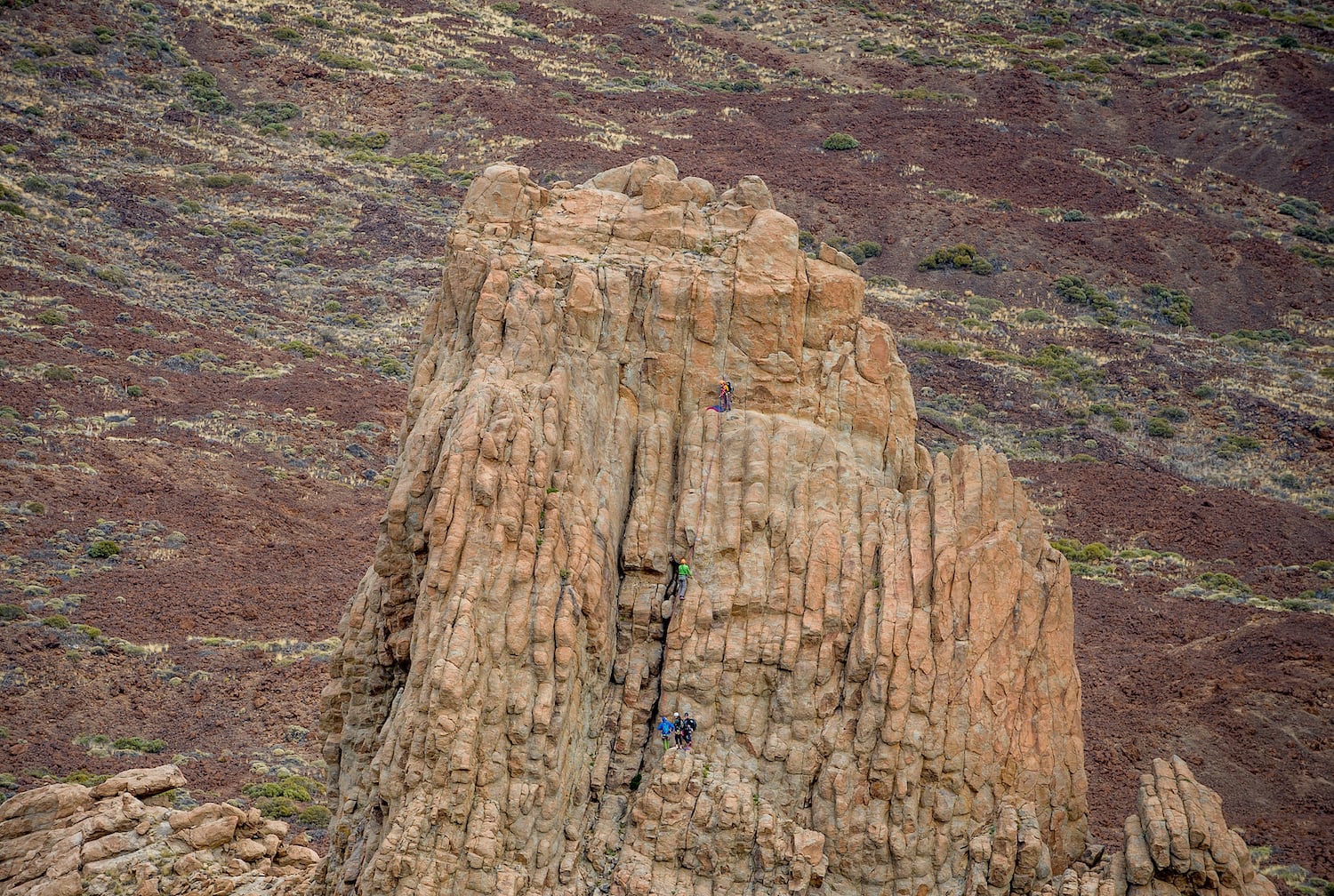
Published on: 09/23/2022
Have you ever wondered how climbers reach the top of gigantic rock walls or the summits of impressive peaks? Well, they perform an advanced style of rock climbing called multi-pitch climbing.
Learning how to multipitch climb is an exciting endeavor! However, it takes time and patience to learn the proper techniques and to remain safe while climbing.
Theorizing and conceptually learning about multi-pitch climbing is an effective way to understand how to get started. But no one article can fully prepare you for learning to multi-pitch.
So with that said, we are glad you are here! Keep reading to learn what multi-pitch climbing is, what equipment you might need, the skills you should know, and tips to get started.
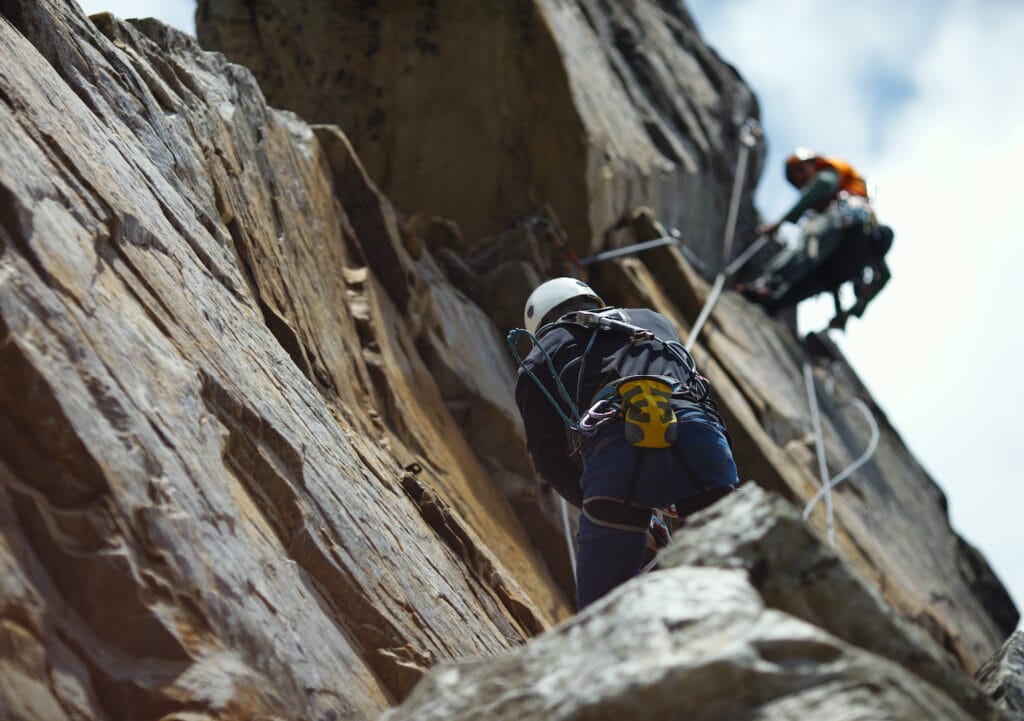
What is Multi-Pitch Climbing?
Multi-pitch climbing is where a rope team ascends a large rock wall or mountain with one or more stops at a belay station on their way to the top of the climb.
In multi-pitch climbing, a “pitch” describes approximately one rope length of distance. However, sometimes, the pitch of climbing is shorter than the entire length of the rope. Typically this is the case when the leader climber wants to mitigate rope drag or stay closer to their second to communicate more clearly.
Multi-pitch climbing differs from single-pitch climbing. For single-pitch climbing, the rock climbers stop once they have reached the anchor at the top of the climb. In most cases, there is no more rock above to continue upwards. Instead of swinging leads and continuing up the next pitch, they lower back down to the ground.

Relation to Trad Climbing
Historically, multi-pitch climbing was made possible using aid climbing (1) and traditional climbing equipment and techniques. To this day, most multi-pitch climbing worldwide is still completed with traditional climbing gear and basic techniques. However, there are some exceptions, with places like El Portrero Chico, Mexico (2) being the most well-known.
On most multi-pitches, two climbers climb, belay, and build anchors using traditional climbing gear instead of clipping bolts. This means that the leader places their gear into the wall to protect themselves in the event of a fall and to build anchors once they’ve reached the end of the pitch. Then, when the next climber follows the pitch, they clean the gear out of the wall to be able to reuse it on the next pitches.
After the first pitch at the belay station, the rope team continues up the route repeating the lead climbing and cleaning process until they’ve reached the top of the climb.
Fundamental Gear
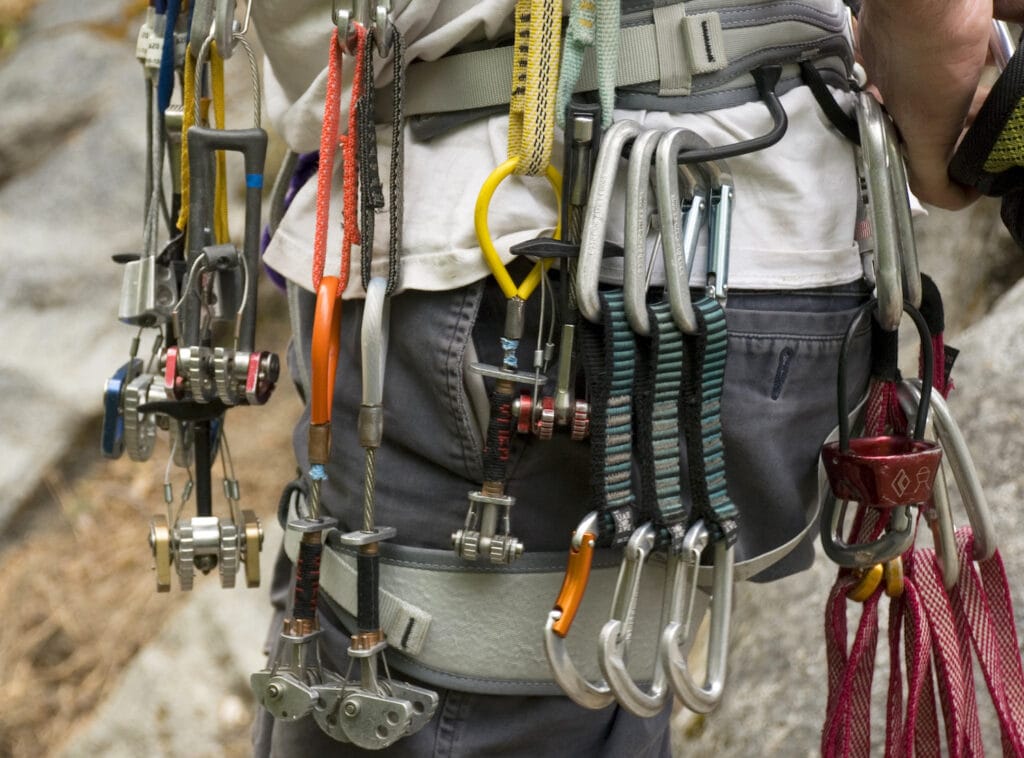
Unlike other climbing styles, such as bouldering, multi-pitch climbing requires quite a lot of fundamental gear. If you are interested in multi-pitch climbing, we recommend taking the time to research what equipment is best for you to purchase.
As a note, what you invest in may depend on what you already have from other climbing styles, such as sport climbing, and what your climbing partner can contribute to the rope team.
But to help you get started brainstorming here is a helpful list of important gear. This shortlist is a great place to start, but it may not include everything.
- Climbing shoes and a light pair of approach shoes
- Helmet
- Harness
- Locking and non-locking carabiners
- Ropes
- A belay device, such as an ATC guide
- Prussik cord, hollow block rappelling, and emergency ascender
- A small pack to carry food, water, first aid kit, headlamp, extra layers, and other gear while climbing
- Quickdraws and “alpine draws,” or extendible quickdraws
- Traditional protection, such as camming devices and stoppers
- Cordalette and a selection of double and triple-length sewn slings
Essential Skills to Learn
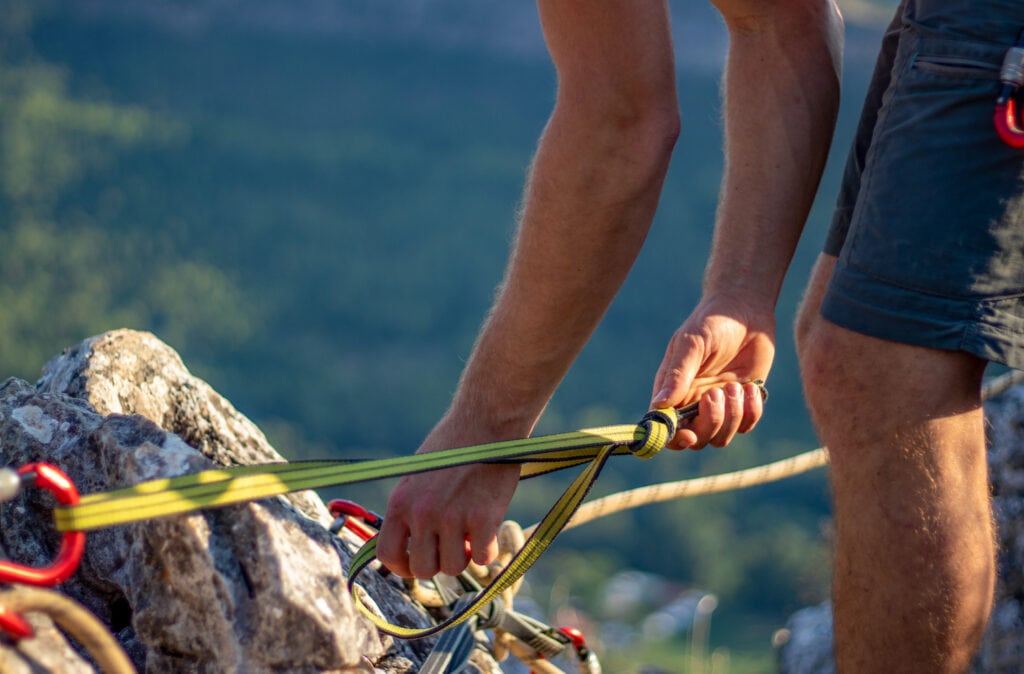
Learning some essential skills and basic techniques is vital before leaving the ground to go multi-pitch climbing safely and efficiently. Below we will briefly talk about six essential skills that you should have mastery over before endeavoring up a multi-pitch rock climb.
Our shortlist of six skills is a fantastic place to start. But it’s not an exhaustive list and does not cover every necessary skill to swing leads on a multi-pitch climb.
- Lead Climbing and Belaying
- Building Anchors
- Belaying from Above
- Cleaning Gear
- Rappelling
- Self Rescue Skills
Lead Climbing and Belaying
Lead climbing is a style of rock climbing where one partner in the rope team takes the lead and climbs first.
The lead climber ascends the wall, periodically clipping their rope into climbing protection, such as quickdraws, camming devices, or stoppers, to protect themselves in the event of a fall as they lead climb. Then, once the lead climber has reached the top of the pitch and constructed an anchor, they can belay from the top and bring up the second climber.
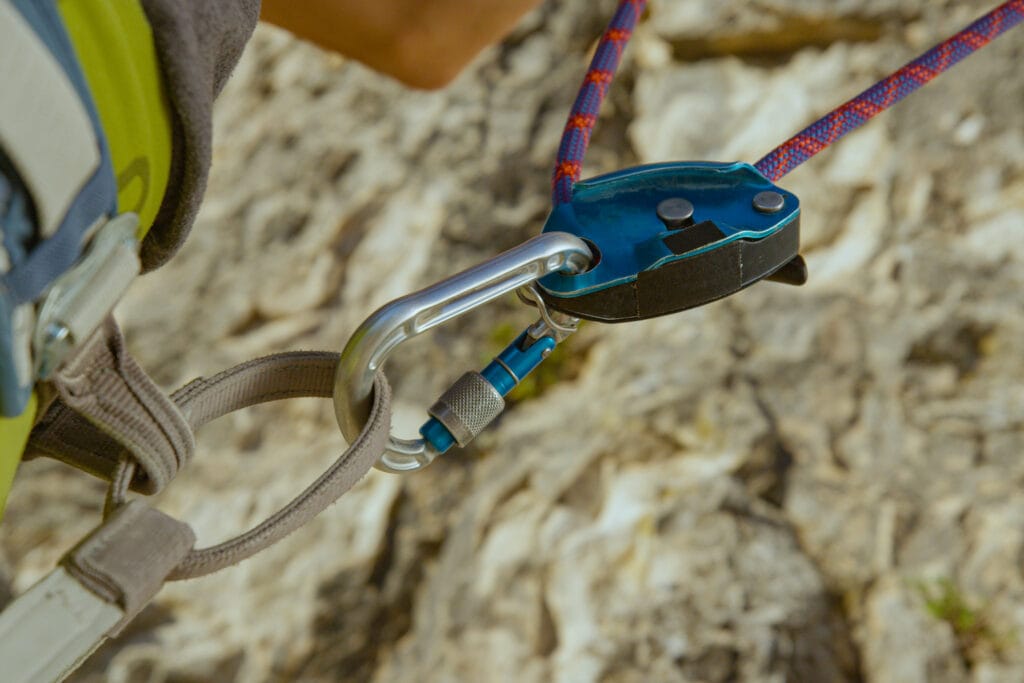
Lead belaying then is the flip side of the coin. As the leader climbs upwards, a lead belayer remains on the ground to provide a belay. As the lead climber advances, the lead belayer feeds the climbing rope through a belay device.
In the event of a fall, the lead belayer will act as a counterweight to the lead climber and catch them before they can hit the ground.
Building Anchors
When lead climbers reach the top of their pitch, they need to build an anchor point to bring up the second climber. Efficiently building safe and robust anchors is an acquired skill that takes years to master.
You should not take this skill lightly. If an anchor point is not adequately built strong enough, a catastrophic anchor failure could occur. This would threaten the lives of everyone in the rope team.
Building strong anchors at belay stations on a multi-pitch route is different every time. The anchor that a climber constructs will vary depending on:
- Type and quality of rock,
- The gear they have remaining,
- Presence (or lack of bolts);
- The number of people in the rope team, among other details.
Belaying From Above

Once the lead climber has built an unquestionably strong anchor, they can tether themselves directly to the anchor (using a personal anchor, for example). Next, they come off belay and prepare to bring up the second climber by belaying from above.
Belaying from above looks different depending on the type of belay device the lead climber prefers to use and the number of ropes the rope team uses to climb.
However, regardless of the device or number of ropes, the goal of belaying from above remains the same. As the second climber climbs upwards, it’s the job of the other climber to take out the slack in the rope system.
In most cases, the tighter the belayer can keep the rope, the better. That’s because, in the event of a fall, the second climber will fall a significantly shorter distance.
However, many climbers prefer a looser belay. This is especially true when the second climber traverses or moves horizontally through the terrain, where a super tight belay might pull them off balance. For maximum comfort, we recommend chatting with your partner to discuss what type of belay they prefer.
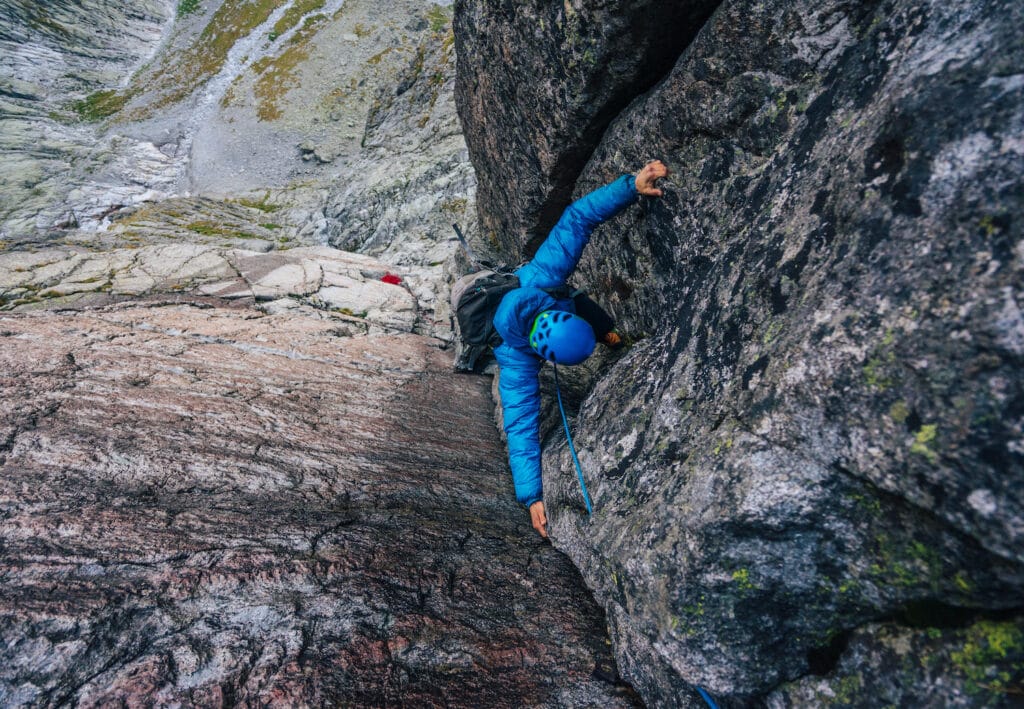
Cleaning Gear
As we discussed above, on a multi-pitch climb, as the leader ascends upwards, they place protection in the rock, i.e., stoppers or camming devices, or on the rock, i.e., bolts and quickdraws, to protect themselves in the event of a fall. They repeat this tactic for multiple pitches, from the first to the last.
Every time the second follows the pitch, it’s their responsibility to clean the gear. Cleaning the gear refers to removing the personal climbing gear of the lead climber from the wall. This way, the climbers can reuse it for the next pitch.
Properly cleaning gear is as essential as placing gear. If one follower cannot remove the piece of gear, the equipment is left behind and becomes unusable for the rest of the climbing.
Rappelling
Once the rope team has reached the top of the last pitch, it becomes time to return down to the ground. On some routes, getting off is as simple as walking off the back down a descent trail. On other routes, if walking off is impossible, the rope team will have to rappel.
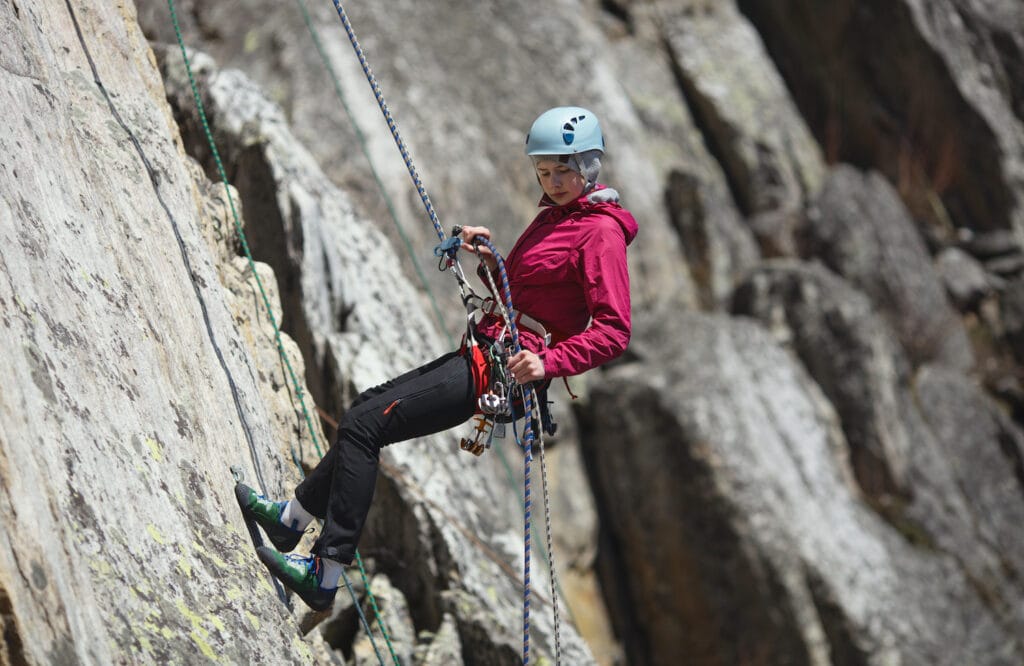
Rappelling, or abseiling in some countries, refers to descending a multi-pitch route on a rope threaded through a strong anchor at the rappel station. The rappeller uses a rappel device to calmly and slowly lowers themselves down the length of the rope until they reach the next rappel station.
Once they’ve reached the next station, they tether themselves to the anchor and free up the rope so their partner can rappel down to them. Once all parties of the rope team have rappelled the pitch, they can pull their climbing rope down to them and repeat the rappelling process until they finish the descent.
Self-Rescue Skills
In a perfect world, whenever a pair of climbers climbed a multi-pitch route, they would get up and down safely with no accidents or emergencies. For the most part, this is true. Multi-pitch routes are climbed every day without a hiccup.
However, what happens if there is an emergency? Like a rock fall event that renders a climber unconscious? Or a rope getting stuck on the rappel descent?
When things go wrong while multi-pitch climbing, the solution to the problem often requires an advanced set of self-rescue skills.
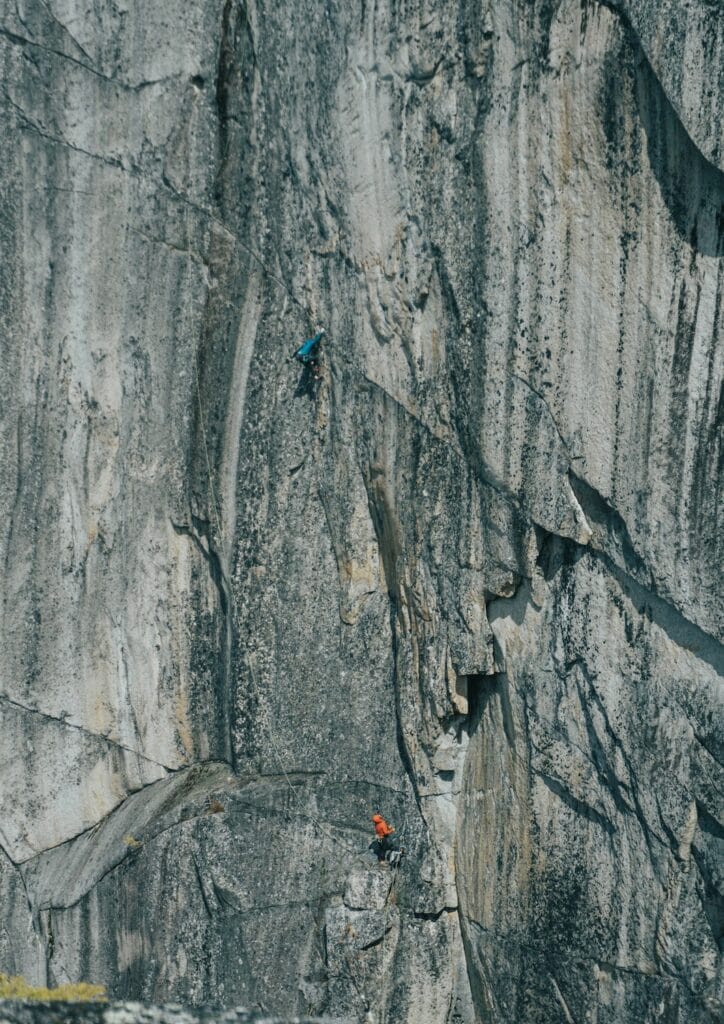
Self-rescue skills, like anchor building, placing protection, and lead climbing, amongst other multi-pitch skills, are vital to the success and safety of the rope team. They are as important as food and water and should be mastered before venturing onto big walls.
Before going to climb, we recommend that you plan, pay careful attention, and take the time to practice self-rescue skills. This way, you will be ready for the unexpected. Below we will talk about only two of many critical self-rescue skills.
Assisted raising, or hauling
It’s one of many critical self-rescue techniques all experienced climbers should know before leaving the ground on a multi-pitch. Hauling refers to utilizing special equipment to create a mechanical advantage to raise a climber without their assistance. Hauling is critical for rescuing climbers, raising a climber through a section they cannot complete, and bringing up heavy equipment onto the wall for a multi-day ascent.
Ascending a rope
Another vital self-rescue skill, ascending a rope, is very important for multi-pitch climbs. Ascending a rope is using special equipment to ascend a rope without using rock climbing hand holds or foot holds. Ascending a rope is especially important for multi-pitch climbing that requires rappelling to descend back down. Indeed, while rappelling, it’s not uncommon for the climbing rope to get stuck after pulling. Depending on the situation, there are various ways to get your rope unstuck. However, one strategy is to have one climber ascend the rope to free it and then continue downwards once again.
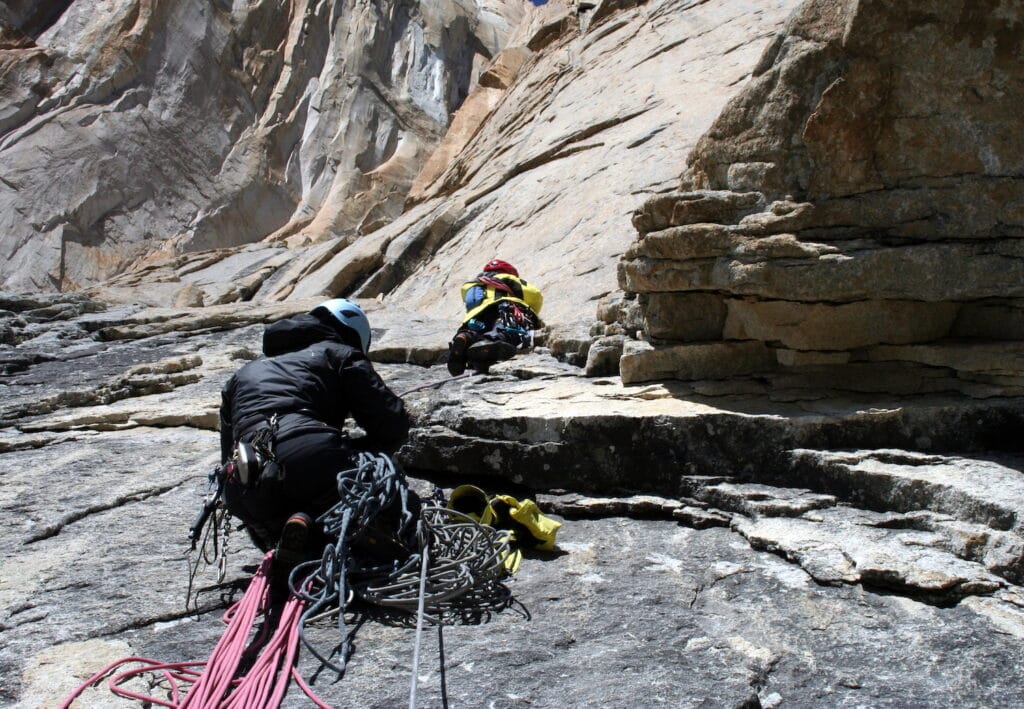
Practical Tips to Get Started
It’s never too late to get started with multi-pitch climbing. With that being said, however, it’s crucial that the budding multi-pitch climber not rush into the experience.
Instead, they should take systematic steps toward gaining the knowledge and skills they will need to safely and efficiently climb multi-pitch routes before leaving the ground on their first big adventure.
Hire a Professional Guide
One of the best ways to learn is with a climbing guide. Professional climbing guides are expert-vetted and experienced instructors who are certified to take you out climbing and help you learn new skills.
Hiring a guide goes beyond just going out to climb for fun. With most climbing guides, you can specifically vouch for the type of day you want and the types of skills you want to learn.
To find the best climbing guides in the United States, we recommend doing a search with the American Mountain Guides Association (AMGA) (3).
Climb with a Reliable Mentor
Historically, climbing has been a sport passed on through generations of mentor-to-mentee instruction. Back in the day, it was common for young climbers to cut their teeth in the sport by learning from more experienced mentors.
This was especially true for trad climbing. The mentee would follow and clean climbs, observing how the more experienced climber led and protected their climb and how they built anchors. Eventually, they would learn enough to be comfortable to venture out on their own.

Learning from a reliable mentor is slightly less common nowadays. This is primarily due to the prevalence of information we have access to and the ease of self-educating oneself with videos and written content like this article.
But climbing with a mentor is still a fantastic strategy to learn how to multi-pitch climb and one that we cannot recommend enough.
Sign-Up for Gym-to-Crag Classes
Nowadays, climbing gyms have become fantastic sources of information and instruction. Depending on the local gym in your area, it may be possible to sign up for gym-to-crag classes that can teach the basic techniques you will need to get started climbing outside.
Practice Placing Gear and Building Anchors on the Ground
Ground school is the safest way to learn new skills. You can practice multi-pitch belays, swinging leads, and belay transitions without the risk of injury or death.
After you’ve committed the new skills to memory and can perform them fluidly, you will know you are ready to leave the ground on your first pitch.
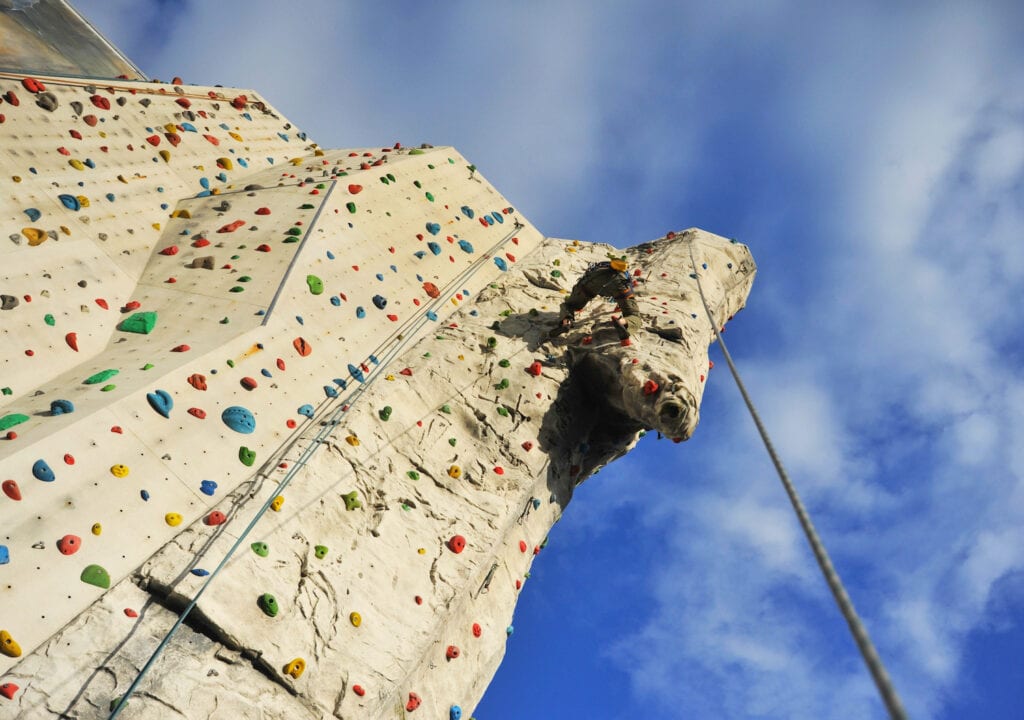
Mock-Lead on Single Pitch Routes
Mock-leading is a popular technique for learning to lead climb. It involves two ropes, one of which has the climber on a top-rope belay, along with a belayer, and the other is the mock-lead line.
As the climber moves upwards, they can practice placing protection and clipping their rope as if they were leading. But in the event of a fall, the top rope will catch them to prevent any serious fall due to catastrophic gear failure.
Afterward, a more experienced mentor or climbing guide can double and triple-check the gear placements to confirm that the practicing climber is ready to begin leading without a backup top rope.
Prepare and Plan Ahead
Multi-pitch rock climbing is no joke. It is a serious endeavor with severe consequences should something go catastrophically wrong.
For that reason, you must prepare and plan before you climb.
Preparing and planning ahead goes beyond just learning basic skills. It includes mastering them in non-stressful situations, often on the ground, and considering other elements of the climb, such as the weather, what food and water you plan to bring, and an emergency backup protocol.
Final Thoughts
When it comes to climbing, there is no better experience than swinging leads with your partner on pitch after pitch of impeccable rock until you reach the top of the climb or the summit of the mountain.
Compared to a sport climb, the adventure and exposure you experience, the vistas you see from the top, and the feelings of satisfaction and contentment you gain are irreplaceable. This is why multi-pitch climbing is so popular.
But multi-pitching should not be underestimated. Instead, you should learn the required skills slowly and methodically under the close guidance of a more experienced mentor or professionally certified climbing guide so that you can climb confidently.
Check out our 7 recommended easy multi-pitch sport climbs in the US to get started progressively with this practice.
